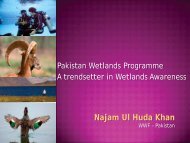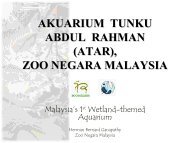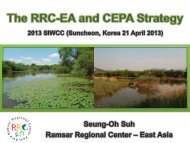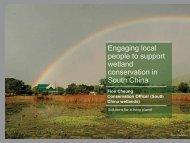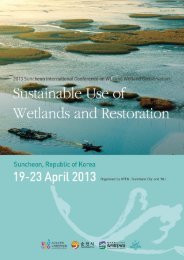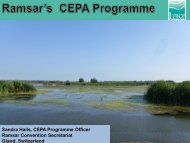The table above shows that <strong>wetland</strong>s are a great conduit for learning about everythingfrom art to zoology. Different aspects of the curriculum will be suitable for differentaudiences at different times.Corporate messages – These are about the organisation running the <strong>wetland</strong> <strong>centre</strong>.What are its vision and mission, aims and objectives, origins, history andachievements? What does it believe in? What does it do? How may the visitorbecome involved?<strong>Wetland</strong> <strong>centre</strong>-specific messages – These are messages that are unique to theindividual <strong>wetland</strong> <strong>centre</strong>. They comprise stories about the place that cover:• Its biodiversity• Its geology and landscape• Its cultural history (including archaeology andindustrial/agricultural past)• Relationship with local and regional community• In addition, a set of key ‘site behaviour’ messages need to beidentified and included within the Interpretation Plan. Often theselink to signage and include such elements as:• Where to go/where am I? – directional signage and maps• Codes of conduct – e.g. being quiet, not running, not dropping litteretc.• What to do with ‘stuff’ – e.g. litter, dogs, lost property (or people)etc.• Where to find information• How to join any appropriate organisation26
Chapter 7 – And to whom?Who will visit your <strong>wetland</strong> <strong>centre</strong>? Will it be local people or tourists? Will theycome from afar or just ‘round the corner’? Will they have specific needs (e.g.birdwatchers)? Have they visited to escape the stress of city life?A detailed analysis of your projected visitors is important before designing the<strong>wetland</strong> <strong>centre</strong>. As well as who they are and where they come from, it is useful toknow their cultural and educational backgrounds (attitudes, previous experiences andprior knowledge). Questionnaires, surveys, interviews, pre-opening preview tours,inviting local residents for a chat and snacks, focus groups, local communityconsultation, reviews of historical data – they’re all ways of learning about the peoplewho will visit and support you.It is not very helpful to refer to the ‘general public’. People are very varied –everyone is individual although you can classify them into certain groups.Marketeers are adept at this, dividing the audience into several smaller groups, anexercise known as segmentation. Your audience segments, for example, mightinclude family groups, schools, seniors, special interest groups and so on.Develop priorities for <strong>developing</strong> existing audiences and encouraging new ones.Have qualitative and quantitative targets for each audience over a one, three, five and10 year span. The key is to know your various visitor markets and what excites them.Then work towards enhancing their visit through the provision of targetedprogrammes and activities, and exceeding their expectations.It is ironic that many of us in <strong>wetland</strong> <strong>centre</strong>s know more about the fish, frogs andwildfowl that live there than the audiences who visit and support the place. Larger<strong>wetland</strong> <strong>centre</strong>s may be able to afford marketing staff and consultants. Smaller<strong>centre</strong>s would do well to develop relationships with social science, marketing,business and tourism schools of local higher education institutions. There are alwaysstudents, from undergraduate to MBA, looking for projects. The WWT London<strong>Wetland</strong>s Centre and Australia’s <strong>Wetland</strong> Centre at Shortlands, New South Wales,have even shared a PhD student who evaluated the effectiveness of theirinterpretation.But <strong>wetland</strong> <strong>centre</strong>s are about influencing and lobbying as well as educating andentertaining general audiences. The Ramsar CEPA Programme identifies some of themore prominent ones (see www.ramsar.org/key_cepa_programme_e.htm). Theyinclude:27




